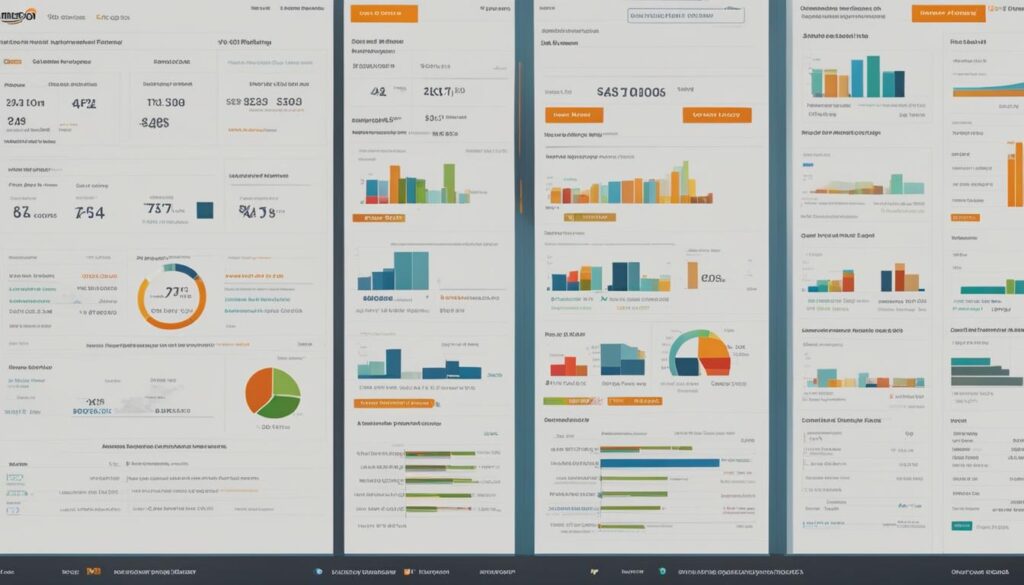In today’s e-commerce landscape, Amazon is the go-to platform for businesses looking to expand their reach and increase sales. However, with thousands of products available, standing out from the crowd can be a daunting task. This is where Amazon SEO comes in. By optimizing your product listing using effective strategies and techniques, you can improve your Amazon search rankings, increase visibility, and boost conversions. In this article, we will explore various aspects of Amazon SEO, including Amazon keyword research, product optimization, and competitor analysis. Let’s dive in!
Key Takeaways:
- Amazon SEO can help optimize sales on the platform
- Effective Amazon SEO strategies include keyword research and product optimization
- Competitor analysis and A/B testing can improve your product visibility
- Enhanced brand content can increase conversions
- Amazon PPC campaigns can be optimized for maximum profitability
Conducting Keyword Research on Amazon
Conducting thorough keyword research that’s specific to Amazon is a crucial step before optimizing your product listing.
When conducting keyword research on Amazon, it’s important to identify keywords with high search volumes and low competition to maximize your product visibility. This can be achieved by using the following effective techniques and tools:
- Amazon Autocomplete: Amazon Autocomplete is a powerful tool that provides relevant keyword suggestions as you type in the search bar. These suggestions are based on the most frequently searched terms, making it an excellent resource for identifying high-traffic keywords.
- Amazon Keyword Tool: Amazon Keyword Tool is a free and user-friendly tool that generates keyword ideas and their search volumes from Amazon’s search engine results pages. This provides a better understanding of consumer search behavior within the Amazon marketplace.
- Competitor Research: Analyzing competitor listings can reveal valuable keyword insights and highlight gaps in their product offering. This in turn can help identify untapped keyword opportunities.
By utilizing these keyword research techniques and tools, you can gain a deeper understanding of how your target audience searches for products on Amazon and optimize your listing accordingly to increase visibility and drive sales.
Optimizing Your Amazon Listing
Optimizing your Amazon listing is a crucial step to improve your product visibility, increase your chances of conversions, and boost your rank on Amazon search results. The following best practices will help you achieve that.
Title
The title of your product listing should be clear, concise, and keyword-rich. It should accurately reflect the product you are selling and make it easy for customers to find it. Consider including the most relevant and popular keywords in your title. However, avoid keyword stuffing, as it can negatively impact your listing’s visibility
Bullet Points
Bullet points are an essential part of your product listing as they provide customers with a quick overview of your product’s key features and benefits. Make sure to highlight the most important and unique features of your product to set it apart from competitors. You can also include any additional product information, such as dimensions or materials, in these bullet points.
Product Description
Your product description should provide more detailed information about your product, its benefits, and how it can solve your customer’s problems. Use persuasive language and highlight the unique selling points of your product. Make sure to keep your paragraphs short and easy to read. Provide answers to frequently asked questions in your description.
Backend Keywords
Backend keywords are hidden keywords that help Amazon’s algorithm understand the relevance of your product listing. Use relevant and popular keywords in your backend to improve your product’s visibility. Avoid using duplicate keywords and unrelated terms.
Images
High-quality images are crucial to improving your product’s visibility and encouraging customers to make a purchase. Use clear and well-lit photos that showcase your product from different angles. Include lifestyle images that show your product in use. Use keywords in your image file names and alt tags to improve your listing’s Amazon SEO.
Boosting Amazon Search Rank
Improving your Amazon rankings is crucial to increasing organic traffic to your product listing. Here are some effective strategies you can use to boost your Amazon SEO:
- Optimize product reviews: Encourage your customers to leave reviews on your product page. Positive reviews can help boost your search rank and improve your credibility with potential customers. Responding to reviews, both positive and negative, can also show that you value your customers and are committed to providing excellent service.
- Leverage customer questions and answers (Q&A): Responding to customer questions in the Q&A section of your product listing not only helps improve the customer experience but can also increase the relevancy of your product for specific search terms.
- Utilize Amazon’s A9 algorithm: Understanding how Amazon’s algorithm works is essential to optimizing your search rank. The A9 algorithm takes into account factors such as product title, features, price, availability, and sales history. Make sure to use relevant and specific keywords in your product title and features, provide competitive pricing, maintain stock availability, and increase sales velocity to improve your chances of ranking higher in Amazon search.
Implementing these strategies can help improve your Amazon search rank and increase your product’s visibility to potential customers.
A Comparison of Search Rank Impact of Amazon SEO Strategies
| Amazon SEO Strategy | Search Rank Impact |
|---|---|
| Optimizing product reviews | Positive impact, boosts credibility and search relevancy |
| Leveraging customer Q&A | Positive impact, increases search relevancy for specific terms |
| Utilizing Amazon’s A9 algorithm | Positive impact, improves chances of ranking higher in Amazon search |
Analyzing Competitor Listings
To stay ahead of the game, it’s essential to analyze your competitor’s listings on Amazon. By conducting an Amazon competitor listing analysis, you can gain valuable insights and improve your own product listing strategy. Don’t forget to analyze their Amazon storefront.
Identifying Keywords
One of the crucial factors to look for in competitor listings is their use of keywords. By identifying their target keywords, you can analyze and compare their strategy to yours, optimizing for a wider range of keywords that can help increase visibility and conversions. The keywords can be found in their product titles, descriptions, backend keywords, bullet points, and reviews.
Analyzing Pricing
Another aspect to consider in competitor listings is their pricing strategy. You can compare their pricing to yours and adjust accordingly to make your product more competitive.

“Analyzing the competition on Amazon is crucial for success. It provides you with insightful data that you can use to your advantage.”
– Amazon seller, John Smith.
Enhanced Brand Content
Take note of your competitor’s use of Enhanced Brand Content (EBC) including their images, videos, and interactive content. Analyzing the use of EBC can improve your product listing and help you stand out from your competitors.
Conducting an Amazon competitor listing analysis requires a thorough and meticulous approach. By identifying your competition’s keywords, pricing strategies, and enhanced brand content, you can gain a competitive edge that drives more traffic and buys to your product listings.
Creating Compelling Enhanced Brand Content
Amazon’s Enhanced Brand Content (EBC) is an excellent way to improve your product listing and convert potential customers into buyers. EBC allows you to showcase your product’s unique features and benefits by using visually engaging multimedia content. It creates a strong emotional connection with your audience and helps you stand out in a crowded marketplace.
When creating your Enhanced Brand Content, keep in mind the keywords you want to target and how you can seamlessly integrate them into the visuals and text. Your content should be engaging, informative, and visually appealing. Use a mix of photos, illustrations, graphs, and charts to create an immersive product experience for customers.
“Enhanced Brand Content can help increase conversions by up to 10%!”
Make sure to highlight your product’s unique selling points (USPs) clearly. Use customer reviews and feedback to showcase your product’s benefits, and describe how it can solve the customer’s pain points. A well-structured EBC tells a story and helps create an emotional connection with the audience, which in turn leads to an increase in sales.
Benefits of Enhanced Brand Content:
| Benefits | Explanation |
|---|---|
| Higher Conversion Rates | EBC helps showcase your product’s unique selling proposition, leading to a higher conversion rate of clickers to buyers. |
| Improved Brand Perception | EBC creates a professional-looking product page that elicits a positive response from potential buyers, leading to a better brand reception. |
| Increased Sales | EBC helps improve product discoverability, which increases your products’ sales in the long run. |
Overall, creating compelling Enhanced Brand Content helps not only increases your sales but also improves your brand awareness and loyalty. A well-written product description and visually pleasing multimedia content can make all the difference. Get started creating your EBC today and transform your Amazon listing for the better!
A/B Testing for Product Optimization
A/B testing is a powerful technique that can help you optimize your product listing and improve your conversion rates. By comparing two different versions of your listing, you can identify which one performs better and make changes accordingly. Here’s how to conduct effective A/B tests:
Step 1: Identify the Elements to Test
Before you begin an A/B test, identify the elements of your product listing that you want to test. These could include your product title, bullet points, product description, or images. Focus on the areas that you think could have the greatest impact on your conversion rates.
Step 2: Create Variations
Create two different variations of your product listing, each with a different set of test elements. For example, you might test two different product titles or two different sets of bullet points.
Step 3: Choose a Testing Tool
To conduct an A/B test, you’ll need a testing tool that can randomly assign visitors to one of the two variations of your product listing. Some popular A/B testing tools for Amazon listings include Splitly, Pickfu, and Helium 10.
Step 4: Conduct the Test
Once you’ve created your variations and chosen a testing tool, it’s time to conduct the test. Make sure to run the test for a long enough period (usually at least a week) to get statistically significant results.
Step 5: Analyze the Results
After the test is complete, analyze the results to determine which version of your product listing performed better. Look at key metrics such as click-through rate, conversion rate, and sales to identify which variation was more effective.
“A/B testing is a continuous process of trial and error. It allows you to experiment with different elements of your product listing to identify the best strategies for improving your conversion rates.”
Step 6: Implement Successful Changes
Based on the results of your A/B test, implement the changes that were successful. This could include updating your product title, rewriting your bullet points, or updating your images. Make sure to continue testing and refining your product listing to achieve the best results.
Optimizing Amazon PPC Campaigns
When it comes to Amazon SEO, optimizing your PPC campaigns is just as crucial as optimizing your product listing. This advertising platform provides an effective way to promote your products, increase visibility, and drive sales. But to get the most out of Amazon PPC, you need to know how to optimize your campaigns for maximum profitability.
Keyword targeting is a crucial aspect of Amazon PPC optimization. By choosing relevant and targeted keywords, you can attract more qualified traffic to your listings, increasing the chances of conversion. Utilize Amazon’s keyword research tools, such as the auto-suggest feature, to help identify effective keywords for your campaigns.
Bid management is another essential aspect to consider when optimizing your Amazon PPC campaigns. You want to strike a balance between bidding high enough to win clicks, while also getting a good return on investment. Analyze your campaign metrics, such as cost-per-click and conversion rates, to adjust your bidding strategy accordingly.
The ad copy is also crucial to the success of your Amazon PPC campaigns. Ensure that your ad copy is compelling, engaging, and highly relevant to the keywords and product being advertised. By crafting persuasive ad copy, you can attract more clicks and increase conversions.
“Optimizing Amazon PPC campaigns requires a strategic approach that involves keyword targeting, bid management, and compelling ad copy. With the right strategies in place, you can increase your sales and profitability on the platform.”
To help you visualize your campaign metrics and make data-driven decisions, consider using a tool such as Jungle Scout to monitor and optimize your campaigns. These tools provide insights into the performance of your ads, allowing you to identify areas for improvement and adjust your strategies accordingly.
In summary, optimizing your Amazon PPC campaigns requires careful planning, monitoring, and analysis. With effective keyword targeting, bid management, and ad copy, you can drive more qualified traffic to your listings and increase conversions. Use data-driven insights and tools to optimize your campaigns for maximum profitability.
Amazon SEO Wrap Up
As you can see, optimizing your Amazon listings using the right Amazon SEO strategies is crucial for the success of your products on the platform. By conducting effective keyword research, optimizing your product listing, analyzing competitors, and utilizing various strategies, you can boost your Amazon SEO and drive more sales to your products.
However, it’s important to remember that Amazon’s A9 algorithm is constantly changing, so staying up to date with the latest Amazon SEO trends and techniques is essential for long-term success. Consider investing in Amazon SEO services or dedicating time and resources to continuously optimize your listings.
Don’t be afraid to experiment with A/B testing and Amazon PPC campaigns to find what works best for your products. With the right approach, Amazon SEO can be a powerful tool in helping your products stand out and drive more sales on the platform.
Thank you for reading and best of luck in optimizing your Amazon listings for success!
FAQ
Why is Amazon SEO important for optimizing sales on the platform?
Amazon SEO plays a crucial role in improving your product visibility and increasing conversions. By implementing effective Amazon SEO strategies, you can enhance your rankings on Amazon’s search results, leading to increased visibility and sales.
How can keyword research on Amazon benefit my product optimization?
Conducting keyword research specific to Amazon allows you to identify relevant keywords that customers are searching for. By incorporating these keywords into your product listing, you increase the chances of your listing appearing in relevant search results, increasing visibility and potential conversions.
What are some best practices for optimizing my Amazon listing?
To optimize your Amazon listing, focus on creating compelling titles, engaging bullet points, informative product descriptions, and relevant backend keywords. Additionally, include high-quality images that showcase your product and create a compelling and persuasive product description to encourage conversions.
How can I improve my Amazon search rankings?
There are several strategies you can implement to boost your Amazon search rankings. These include optimizing your product reviews, leveraging customer questions and answers, and understanding and utilizing Amazon’s A9 algorithm effectively.
Is analyzing my competitors’ listings beneficial for my Amazon SEO?
Yes, analyzing your competitors’ listings can provide valuable insights and help you gain a competitive edge. By understanding their keywords, pricing strategies, and enhanced brand content, you can optimize your listing and differentiate your product from the competition.
How can enhanced brand content improve my Amazon listing?
Enhanced brand content allows you to create engaging and informative content to showcase your brand and products. This feature can positively impact your sales by providing customers with a better understanding of your brand and products, leading to increased conversions.
What is A/B testing, and how can it optimize my product listing?
A/B testing involves comparing different versions of your product listing to determine which performs better. By conducting A/B tests, you can identify elements that resonate with your target audience, leading to improved conversion rates and overall optimization of your listing.
How can I optimize my Amazon PPC campaigns for better results?
Optimizing your Amazon PPC campaigns involves various factors such as keyword targeting, bid management, and compelling ad copywriting. By focusing on these aspects, you can increase the effectiveness of your PPC campaigns and generate higher returns on investment.
Why should I prioritize implementing effective Amazon SEO strategies?
Implementing effective Amazon SEO strategies is crucial for maximizing your product visibility and sales on the platform. By optimizing your listing, conducting keyword research, analyzing competitors, and implementing various strategies, you can enhance your Amazon SEO and achieve your desired results.




